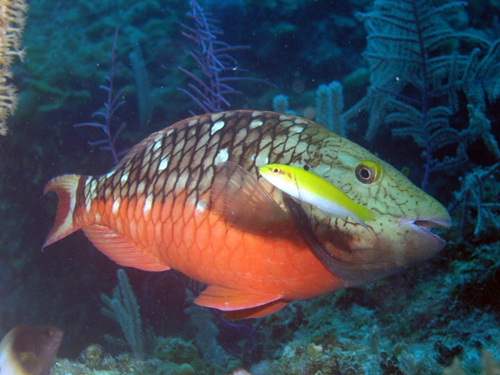
Parrot Fish. Photo: Melinda Riger for Grand Bahama Scuba.
|
In 2005, the Ministry of Tourism declared April Coastal Awareness Month.
Now in its 4th year, there are 5 key threats that continue to be relevant to our coastal environment.
Those 5 key threats are climate change, habitat destruction, invasive species, pollution, and over-fishing.
As 2008 has once again been declared by the ICRI (www.icriforum.org) as International Year of the Reef (www.iyor.org) – 10 years after International Year of the Reef 1997 – special emphasis is being put on our coral reef ecosystems.

Parrot Fish Photo: Melinda Riger for Grand Bahama Scuba.
|
In light of this I will discuss how these key threats affect coral reef ecosystems.
-
Overall Implications of Coral Reef Degradation
-
Coastal erosion
-
No breakwater to minimize wave action on the shoreline, or allow for maximum sand accretion on the shoreline.
-
Loss of sand production
-
Sand is the product of disintegrated hard coral that is the by-product of the parrotfish’s feeding process.
-
Vulnerability to storm surge
-
The lack of a breakwater would leave our islands highly vulnerable to flooding from the highly powerful natural force of our tides, especially due to the low-lying topography of our islands.
1.
Climate Change
a.
Implications
i.
Coral bleaching
1.
Coral polyps have a sensitive symbiotic relationship with specific algae that give the reef its color, as well as provide food for it.
When temperatures get outside of the reef’s comfort zone, the algae cannot efficiently produce food for the coral, and so the coral essentially ‘evict’ the algae.
This leaves the coral a ghostly white.
The effect is not fatal, but without new ‘tenants’ to provide food, hard coral would die.
ii.
Acidification
1.
The increase in carbon in the atmosphere (through CO2 & CH4 primarily) would mean the increase of carbonic acid (H2CO3).
Since hard reef-building coral are composed of an alkaline substance (calcium carbonate – CaCO3), the presence of hard corals will diminish due to neutralization.
b.
What Can We Do?
i.
Invest in cleaner fuels
ii.
Reduce energy consumption
iii.
Urge biggest culprits to invest in cleaner fuels
2.
Habitat Destruction
a.
Implications
i.
(Self-explanatory)
b.
What Can We Do?
i.
Don’t touch corals
ii.
Don’t drop anchor in the vicinity of corals.
In addition to the anchor itself damaging the reef, the chain that holds the anchor can also damage the reef on impact.
Use mooring instead, or anchor a safe distance from reefs.
3.
Invasive Species
a.
Implications
i.
Loss of reef maintenance organisms.
b.
What Can We Do?
i.
Understand the breeding/feeding behaviors of exotic marine life before deciding to acquire one as a pet.
ii.
Understand the implications of the release of an exotic marine animal into the wild.
iii.
Set maximum catch size limits to ensure reproductive fish remain that aren’t on the invasive species’ menu.
4.
Pollution
a.
Implications
i.
Algal suffocation
1.
Eutrophication leads to algal blooms which essentially smother the reefs
ii.
Inability to heal
1.
Nutrient-rich waters inhibit the coral’s ability to heal itself from damage.
b.
What Can We Do?
i.
Reduce use of harmful chemicals
ii.
Don’t pump-out at sea.
iii.
Use non-toxic anti-fouling paints
5.
Over-fishing
a.
Implications
i.
Loss of herbivorous marine animals that control algal populations on reefs.
ii.
Loss of other marine animals such as spiny lobsters (crawfish) that control populations of coralivorous snails.
b.
What Can We Do?
i.
Enforce maximum catch size/quantities for marine catch.

Lion Fish. Photo: Melinda Riger for Grand Bahama Scuba.
|
About the Author: Andre Cartwright is
Sustainable Tourism Development Officer at the Ministry of Tourism & Aviation/IYOR 2008 Focal Point - The Bahamas.
C
ontact Mr. Cartwright at
ajcartwright@bahamas.com
in
